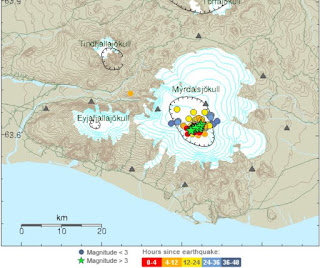#11,778
While we watch as avian influenza viruses make tentative jumps to humans - and are justifiably concerned over
their pandemic potential - many researchers believe that pigs may pose an even bigger risk of producing the next pandemic virus.
Last December, in
PNAS: The Pandemic Potential Of Eurasian Avian-like H1N1 (EAH1N1) Swine Influenza, we looked at a study where researchers had isolated and characterized a number
avian H1N1 virus variants circulating in Chinese pigs that had the ability to infect, and potentially transmit efficiently, in humans.
In the `
Significance' section the authors boiled it down to this:
Here, we found that, after long-term evolution in pigs, the
EAH1N1 SIVs have obtained the traits to cause a human influenza pandemic.
Xinhua News carried an English Language report on this study, with
interviews with the lead author, which you can read at the following
link:
Avian-like H1N1 swine flu may "pose highest pandemic threat": study
In March of this year (see
WHO: H1N1v Cases In China), it was revealed that during 2015 China had reported
3 H1N1v infections, including a 30 month old boy from Hunan Province, described as follows:
A 2.5-year-old male from Hunan Province with
illness onset on 30 June 2015 was detected through sentinel Severe Acute
Respiratory Infection (SARI) surveillance. The patient was hospitalized
with pneumonia and later recovered. He had no underlying medical
conditions. The case investigation found that the case was exposed to
pigs in his village.
And in June, in
Sci Rpts: Transmission & Pathogenicity Of Novel Swine Flu Reassortant Viruses we looked at another study - again out of China - where researchers experimentally infected pigs with one of these
Eurasian-Avian H1N1 swine influenza viruses and the
2009 H1N1pdm virus.
In doing so, they generated yielded
55 novel reassortant viruses spread
across
17 genotypes, demonstrating not only how readily EAH1N1 SIV can
reassort with human H1N1pdm in a swine host, but also finding:
`Most of reassortant viruses were more pathogenic and
contagious than the parental EA viruses in mice and guinea pigs'.
All of which brings us to an
EID Journal report today, on the 30-month old child from Hunan Province, who was infected with one of these reassortant EAH1N1 viruses.
Not only do we learn about the course, and severity, of the child's illness, we also learn that in a mouse model, this reassortant virus displayed increased infectivity and virulence.
It's a long, detailed report, and you'll probably want to read it in its entirety. I've provided some excerpts below:
Volume 22, Number 11—November 2016
Research
Reassortant Eurasian Avian-Like Influenza A(H1N1) Virus from a Severely Ill Child, Hunan Province, China, 2015
Wenfei Zhu1, Hong Zhang1, Xingyu Xiang1, Lili Zhong, Lei Yang, Junfeng Guo, Yiran Xie, Fangcai Li, Zhihong Deng, Hong Feng, Yiwei Huang, Shixiong Hu, Xin Xu, Xiaohui Zou, Xiaodan Li, Tian Bai, Yongkun Chen, Zi Li, Junhua LiComments to Author , and Yuelong Shu Comments to Author
Abstract
In 2015, a novel influenza A(H1N1) virus was isolated from a boy in China who had severe pneumonia. The virus was a genetic reassortant of Eurasian avian-like influenza A(H1N1) (EA-H1N1) virus. The hemagglutinin, neuraminidase, and matrix genes of the reassortant virus were highly similar to genes in EA-H1N1 swine influenza viruses, the polybasic 1 and 2, polymerase acidic, and nucleoprotein genes originated from influenza A(H1N1)pdm09 virus, and the nonstructural protein gene derived from classical swine influenza A(H1N1) (CS H1N1) virus.
In a mouse model, the reassortant virus, termed influenza A/Hunan/42443/2015(H1N1) virus, showed higher infectivity and virulence than another human EA-H1N1 isolate, influenza A/Jiangsu/1/2011(H1N1) virus. In the respiratory tract of mice, virus replication by influenza A/Hunan/42443/2015(H1N1) virus was substantially higher than that by influenza A/Jiangsu/1/2011(H1N1) virus.
Human-to-human transmission of influenza A/Hunan/42443/2015(H1N1) virus has not been detected; however, given the circulation of novel EA-H1N1 viruses in pigs, enhanced surveillance should be instituted among swine and humans.
(SNIP)
EA-H1N1 SIVs have been shown to preferentially bind to human-type
receptors, and ferrets have been experimentally infected with some
EA-H1N1 SIVs via respiratory droplet transmission (12).
EA-H1N1 SIVs reportedly have the potential to transmit efficiently and
cause a pandemic among humans after long-term evolution in pigs (12).
We report a severe human infection with a reassortant influenza virus
in China and the results of genetic, infectivity, and virulence
investigations of the novel virus.
(SNIP)
Discussion
In conclusion, EA-H1N1 swine influenza viruses occasionally infect
humans. We report on a novel EA-H1N1 virus reassortant, HuN EA-H1N1
virus, which was isolated from a boy in China with severe pneumonia. The
virus contained 2 surface genes from an EA-H1N1 virus and 4 internal
genes from A(H1N1)pdm09 virus.
Compared with JS/1/11 EA-H1N1 virus, the
reassortant virus exhibited higher infectivity, virulence, and
replication in C57BL/6J mice, demonstrating the need for further
evaluation of HuN EA-H1N1 virus to assess the threat it poses to public
health. Our results indicate the need for heightened surveillance.
Dr. Zhu is an influenza researcher at the Chinese National Influenza
Center, National Institute for Viral Disease Control and Prevention,
Chinese Center for Disease Control and Prevention. Her research
interests include evolutionary analysis and pathogenicity mechanism of
influenza viruses.
Since the influenza subtypes that commonly circulate in swine (H1, H2
& H3) are also the same that have caused all of the human pandemics
going back 130 years (see
Are Influenza Pandemic Viruses Members Of An Exclusive Club?), they are generally regarded as having less far to `
jump’ to humans than many avian viruses.
Which is precisely how the H1N1 pandemic virus emerged in 2009, after kicking around (and reassorting in) swine herds for a decade or longer.
Which is why we watch reports like today's with particular interest. For more on swine variant viruses, both in the United States and around the world, you may wish to revisit:
Eurosurveillance: Seroprevalence Of Cross-Reactive Antibodies To Swine H3N2v – Germany
JID: Evolutionary Dynamics Of Influenza A Viruses In US Exhibition Swine
Live Markets & Novel Flu Risks In The United States




















